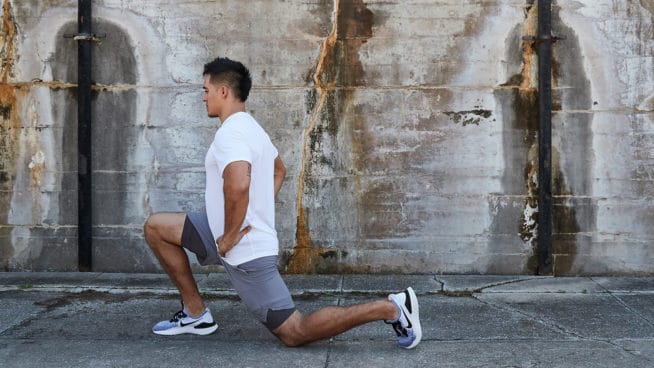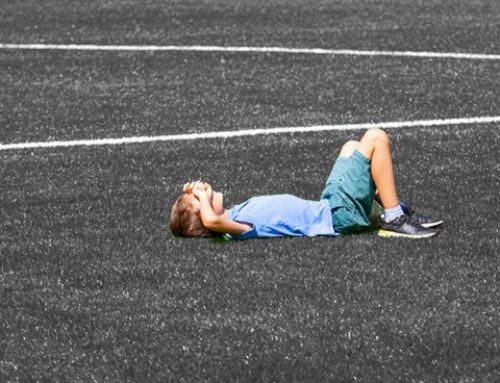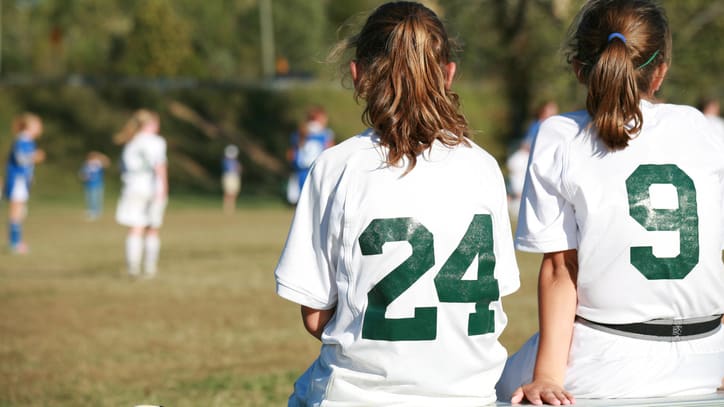Understanding and Avoiding Sports Injuries
Most competitive athletes have sustained an injury. Obviously, injuries can be painful, frustrating and demoralizing. Some injured athletes take months, or even years, to regain full performance.
To avoid long recovery times, take a proactive approach against injuries. Learn how and why they occur and what can be done to prevent them.
How and Why Sports Injuries Occur
Here are some stats on high school sports-related injuries to bones, muscles, ligaments and tendons:
- 1.4 million injuries [meaning the athlete is unable to perform for more than one day] occur each year, out of a population of seven million high school athletes <note i>
- More injuries occur during competition than practice, and they tend to be more severe <note ii>
- 80 percent are new injuries rather than aggravations of previous injuries <note ii>
- More than half of injuries occur in the lower body, the most common being ankle sprains <note i>
Types of Sports Injuries
There are three categories of musculoskeletal injuries—contact, non-contact and overuse. Contact injuries occur when an athlete receives an external blow that exceeds the limits of a body part’s ability to withstand force—for example, when a hockey player is blindsided on the boards, resulting in a concussion. Sports like football and ice hockey have the most contact injuries; however, they can occur in almost every sport.
Non-contact injuries occur when a self-generated force or movement exceeds a body part’s ability to withstand force. A common example is landing awkwardly from a jump, resulting in knee ligament damage. Most non-contact injuries occur during execution of a closed-chain [feet on ground] movement, such as twisting on a planted leg.
Overuse injuries result from a repetitive motion. Pitchers, quarterbacks and tennis players are at high risk for overuse injuries, because they continually place tremendous stress on their shoulders and elbows. The repetitive stress eventually begins to wear down tendons, ligaments, muscles and/or joints, resulting in pain and swelling. When participating in sports that require repetitive movements, be aware of any pain and take immediate steps to reduce the risk of further injury.
Preventing Injuries
To avoid injury, you must take a proactive approach by incorporating prehabilitation into your workout routine. Prehab is a set of exercises designed specifically to prevent injury and prepare the body for the rigors of competition.
At the start, your workout should include a dynamic warm-up, which also serves as prehab. “A proper warm-up is the number one way to prevent an injury,” says Justin Robinson, director of strength and conditioning at Rehab United Physical Therapy and Sports Performance Center [San Diego]. “The general [warm-up] increases body temperature and fluid in the joints, while the specific warm-up mimics motions that will be used for practice or a game that day.”
The following warm-up should be performed in all three planes of motion—forward and backward, side-to-side, and rotational.
Lunge Reach Matrix
- Start in neutral position with feet together
- Step forward with right leg into forward lunge position [sagittal]; return to start position
- Step to right with right leg into side lunge position [frontal]; return to start position
- Step back at 45-degree angle with right leg [transverse]; return to start position
- Repeat pattern for specified reps
Sets/Reps: 1×5 each leg, with one rep equaling a lunge in each direction
Sagittal Jump Starts
- Make a line on floor using tape or chalk
- With feet together, quickly jump front-to-back over line for 10 seconds
- On coach’s command, sprint 15 yards
Sets/Reps: 2×1
Frontal Jump Starts
- Quickly jump with feet together side-to-side for 10 seconds
- On coach’s command, sprint 15 yards
Sets/Reps: 2×1
Transverse Jump Starts
- Jump and quickly turn hips left, then right for 10 seconds
- On coach’s command, sprint 15 yards
Sets/Reps: 2×1
As mentioned above, the ankle is the most commonly injured joint, because it must support your entire weight under enormous stress when landing from a jump or changing direction. In the video above, Fitness Quest 10 owner Todd Durkin has Drew Brees perform an exercise on an unstable surface to strengthen his ankle stability muscles and fortify the joint.
Finally, the shoulder is another commonly injured joint due to its reliance on muscles for support—a trade-off for its large range of motion. To prevent overuse injuries to small supporting muscles, such as the rotator cuff muscles, regularly perform exercises that activate them. In the video below, softball pitcher Monica Abbott performs a shoulder prehab program.
Notes
i Hootman, J. E. [2007]. Epidemiology of Collegiate Injuries for 15 Sports: Summary and Recommendations for Injury Prevention Initiatives. Journal of Athletic Training , 311-319.
ii Centers for Disease Control and Prevention. [2006, September 29]. Sports-Related Injuries Among High School Athletes – United States, 2005-06 School Year. Retrieved April 4, 2011, from Morbidity and Mortality Weekly Report: http://www.cdc.gov/mmwr/preview/mmwrhtml/mm5538a1.htm.
Photo: AP/John Bozeman
RECOMMENDED FOR YOU
MOST POPULAR
Understanding and Avoiding Sports Injuries
Most competitive athletes have sustained an injury. Obviously, injuries can be painful, frustrating and demoralizing. Some injured athletes take months, or even years, to regain full performance.
To avoid long recovery times, take a proactive approach against injuries. Learn how and why they occur and what can be done to prevent them.
How and Why Sports Injuries Occur
Here are some stats on high school sports-related injuries to bones, muscles, ligaments and tendons:
- 1.4 million injuries [meaning the athlete is unable to perform for more than one day] occur each year, out of a population of seven million high school athletes <note i>
- More injuries occur during competition than practice, and they tend to be more severe <note ii>
- 80 percent are new injuries rather than aggravations of previous injuries <note ii>
- More than half of injuries occur in the lower body, the most common being ankle sprains <note i>
Types of Sports Injuries
There are three categories of musculoskeletal injuries—contact, non-contact and overuse. Contact injuries occur when an athlete receives an external blow that exceeds the limits of a body part’s ability to withstand force—for example, when a hockey player is blindsided on the boards, resulting in a concussion. Sports like football and ice hockey have the most contact injuries; however, they can occur in almost every sport.
Non-contact injuries occur when a self-generated force or movement exceeds a body part’s ability to withstand force. A common example is landing awkwardly from a jump, resulting in knee ligament damage. Most non-contact injuries occur during execution of a closed-chain [feet on ground] movement, such as twisting on a planted leg.
Overuse injuries result from a repetitive motion. Pitchers, quarterbacks and tennis players are at high risk for overuse injuries, because they continually place tremendous stress on their shoulders and elbows. The repetitive stress eventually begins to wear down tendons, ligaments, muscles and/or joints, resulting in pain and swelling. When participating in sports that require repetitive movements, be aware of any pain and take immediate steps to reduce the risk of further injury.
Preventing Injuries
To avoid injury, you must take a proactive approach by incorporating prehabilitation into your workout routine. Prehab is a set of exercises designed specifically to prevent injury and prepare the body for the rigors of competition.
At the start, your workout should include a dynamic warm-up, which also serves as prehab. “A proper warm-up is the number one way to prevent an injury,” says Justin Robinson, director of strength and conditioning at Rehab United Physical Therapy and Sports Performance Center [San Diego]. “The general [warm-up] increases body temperature and fluid in the joints, while the specific warm-up mimics motions that will be used for practice or a game that day.”
The following warm-up should be performed in all three planes of motion—forward and backward, side-to-side, and rotational.
Lunge Reach Matrix
- Start in neutral position with feet together
- Step forward with right leg into forward lunge position [sagittal]; return to start position
- Step to right with right leg into side lunge position [frontal]; return to start position
- Step back at 45-degree angle with right leg [transverse]; return to start position
- Repeat pattern for specified reps
Sets/Reps: 1×5 each leg, with one rep equaling a lunge in each direction
Sagittal Jump Starts
- Make a line on floor using tape or chalk
- With feet together, quickly jump front-to-back over line for 10 seconds
- On coach’s command, sprint 15 yards
Sets/Reps: 2×1
Frontal Jump Starts
- Quickly jump with feet together side-to-side for 10 seconds
- On coach’s command, sprint 15 yards
Sets/Reps: 2×1
Transverse Jump Starts
- Jump and quickly turn hips left, then right for 10 seconds
- On coach’s command, sprint 15 yards
Sets/Reps: 2×1
As mentioned above, the ankle is the most commonly injured joint, because it must support your entire weight under enormous stress when landing from a jump or changing direction. In the video above, Fitness Quest 10 owner Todd Durkin has Drew Brees perform an exercise on an unstable surface to strengthen his ankle stability muscles and fortify the joint.
Finally, the shoulder is another commonly injured joint due to its reliance on muscles for support—a trade-off for its large range of motion. To prevent overuse injuries to small supporting muscles, such as the rotator cuff muscles, regularly perform exercises that activate them. In the video below, softball pitcher Monica Abbott performs a shoulder prehab program.
Notes
i Hootman, J. E. [2007]. Epidemiology of Collegiate Injuries for 15 Sports: Summary and Recommendations for Injury Prevention Initiatives. Journal of Athletic Training , 311-319.
ii Centers for Disease Control and Prevention. [2006, September 29]. Sports-Related Injuries Among High School Athletes – United States, 2005-06 School Year. Retrieved April 4, 2011, from Morbidity and Mortality Weekly Report: http://www.cdc.gov/mmwr/preview/mmwrhtml/mm5538a1.htm.
Photo: AP/John Bozeman











